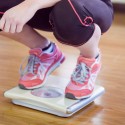Sciatic Nerve Pain Relief: 8 Science-Backed Natural Treatments
For those who suffer from lower back pain, you may be part of a smaller percentage of people whose pain includes discomfort that radiates all the way down your legs.
If your nagging lower back pain involves tingling or stabbing pain in one or both legs, muscle twitches, or other symptoms, you may have sciatica or sciatic nerve pain.
While this condition can be severe, there are many ways you can treat it, whether through conventional medicine or natural therapies.
Our guide helps you understand sciatic nerve pain, its treatments, and how to prevent this disabling condition.
Sciatic nerve pain can appear and disappear, sometimes quickly, but may occasionally last weeks or even months.
When you experience sciatic nerve pain, you may often feel unable to perform everyday functions.
Since the sciatic nerve is the largest single nerve in your body, when it is inflamed, it has the potential to cause many problems.
Learn more below about how to prevent and treat sciatic nerve pain, including natural treatments that you can do at home to keep your back healthy and avoid future problems.
Understanding Sciatic Nerve Pain
You have many nerves running through your lower spine, or lumbar region.
If the largest of these nerves – your sciatic nerve – or any of the smaller nerves that branch off from your sciatic nerve become pinched, this can trigger a radiating pain that is very intense and uncomfortable.
Sciatic nerve pain can extend to one or both legs, possibly all the way to your feet, and can even radiate up your back and throughout your buttocks.
The pain caused by a pinched sciatic nerve is usually very repetitive, and while some experience it in only one leg, others, unfortunately, feel it in both.
Sciatic nerve pain can be very painful and is often described as “intolerable” by sufferers.
Until you know how sciatic nerve pain develops, it can be difficult to prevent and treat.
Diagnosis is sometimes tricky, as symptoms resemble those of arthritis and other back problems.
Symptoms of Sciatic Nerve Pain
Those with sciatic nerve pain most often experience (1):
- Pain, often very strong, sometimes shooting through the lower back and limbs;
- Pain, sometimes described as burning, that begins in the lumbar region and radiates to the buttocks and thighs;
- Difficulty exercising or moving;
- Numbness or tingling in hands and/or feet;
- Stiffness in the feet, sometimes with the inability to flex them properly;
- Inflammation and throbbing pain in the lumbar region or thighs, mainly when seated or standing for extended periods;
- Pain while sleeping.
Sciatic nerve pain usually lasts six weeks or less, but chronic pain can develop if the underlying cause is not alleviated.
Sciatica can come and go, making it hard to treat and offering false hope when it resolves temporarily.
Sciatica can affect people of all activity levels, including athletes.
If you are experiencing sciatic nerve pain that is not resolving on its own or is getting worse or interfering with your ability to work or live normally, you may decide to seek medical attention for your pain.
What Causes Sciatic Nerve Pain?
Herniated discs are the number one cause of sciatic nerve pain.
The area between two vertebrae is called a disc.
This connective tissue, made mostly from collagen, cushions the two bones and reduces friction and irritation where they meet.
When this connective tissue becomes inflamed or injured, it causes herniation or bulging.
When this inflamed tissue comes into contact with the sciatic nerve or impinges on the space the nerve occupies, pain and inflammation develop.
Because the discs in your vertebrae are shock absorbers for your spine’s everyday movements, it is essential that they remain elastic to handle the pressure and vibrations of your activity.
When these discs stiffen from loss of elasticity, they are more likely to develop cracks and tears that cause them to stick out from the surrounding bone, irritating nearby tissues, and nerves.
Around two percent of the population is likely to develop a herniated disc at some point in their lives.
Men are more likely than women to have a herniation, and those over 30 are more likely than younger people to develop disc problems.
Not everyone with a herniated disc will experience sciatic nerve pain, though.
Only when herniated discs bulge out in specific areas so they can pinch the nearby sciatic nerve, resulting in the nerve pain and symptoms previously described.
Because the sciatic nerve is the primary neural channel between your brain and lower extremities, and because many nerve branches connect to this vital neuron, when it is inflamed or pinched, symptoms can be widespread.
For most of us, slipped or herniated discs occur because of years of stress on our bodies.
After a lifetime of poor posture, bad exercise habits, injuries, inflammatory diseases, and other aging issues, our discs are not able to perform as they should.
This increases the likelihood of problems like herniated discs and, thus, sciatic nerve pain.
While herniated discs are the leading culprit for sciatic nerve pain, other conditions or injuries can also cause sciatica.
Doctors believe that it is actually inflammation that causes sciatic nerve pain, and this inflammation can come from a number of sources.
Researchers have noted that you can have sciatic nerve pain even when there is no compression of the root nerve.
Instead, inflammation can be constricting the nerve, triggering it to fire, often chronically and repeatedly, resulting in significant pain (2).
Some factors can increase your odds of having sciatic nerve pain, as well.
If you are older, tall, obese, smoke cigarettes, lead a mostly sedentary life or experience regular vibrations such as those from a vehicle, you are more prone to develop sciatic nerve pain and the conditions that cause it.
All of these factors contribute to back problems over time.
Other conditions, such as spinal stenosis and piriformis syndrome are also linked to sciatic nerve pain.
Spinal stenosis, or the narrowing of the spinal column, is usually caused by aging.
When the piriformis muscle of the buttocks becomes inflamed, it can irritate the sciatic nerve as well, resulting in the aptly-named syndrome.
Taking care of your spine and the surrounding muscles and tissues is, therefore, a significant part of maintaining excellent health.
A healthy diet and regular exercise can greatly contribute to keeping your spine in good working order, providing your discs and other connective tissue with the nutrients, vitamins, and muscle support they need to remain elastic over time.
Medical Approaches to Sciatic Nerve Pain
When your pain has lasted for more than six weeks, it is likely time to seek medical help.
The condition is unlikely to resolve on its own after this point.
While some patients notice an immediate or rapid improvement in their sciatic nerve pain with treatment, others may have pain for years, despite any attempts to resolve the problem.
Acute sciatica is common, and most people recover well with treatment, but as many as one-third of the people with sciatic nerve pain experience symptoms for more than one year (3).
If you have ongoing numbness in your buttocks or thighs, you may have permanent nerve damage or another serious medical problem.
See your doctor if your nerve pain is extreme, lasts more than six weeks, or worsens despite treatment.
There is good news for those with sciatic nerve pain.
Conventional medical interventions include pain medications as well as surgery to correct herniated discs and other spinal issues that are pinching the sciatic nerve.
Be aware, though, that research supports less-invasive therapies for sciatica over surgery and the use of narcotics.
Natural and more holistic approaches can produce equivalent or even better results than surgery (4).
Many natural treatments can help alleviate your pain and improve your symptoms.
Natural Ways to Treat Sciatic Nerve Pain
When treating sciatic nerve pain, you want to be sure you are also treating the underlying problem.
Treatments must work on the root cause, or the pain will never fully resolve.
While medical therapies such as pain medications, steroids, and muscle relaxers may work, there is sufficient evidence to suggest that natural treatments can not only alleviate the pain but also help resolve its underlying cause.
Natural treatments for sciatic nerve pain can not only relieve the symptoms caused by inflammation, but can also help reduce stress, improve your range of motion, and help prevent future injuries and spinal problems.
Here are our top natural treatments for sciatic nerve pain.
Stretching and Yoga
There are some types of movement that can aggravate sciatic nerve pain, including squatting, shortening of the spine, or bringing your knees to your chest.
These all compress your spine and can exacerbate sciatic nerve pain symptoms.
Exercises that elongate your spine and stretch the surrounding muscles, though, are often very useful for alleviating sciatic nerve pain.
Yoga and regular stretching can help strengthen your overall spine and core, improve your posture, and alleviate inflammation, stiffness, and pain.
Yoga is a safe, natural therapy that is proven effective for those with sciatic nerve pain (5).
If inflammation of your piriformis muscle causes your sciatica, the yoga pose known as pigeon is a very useful stretch for relieving pressure and pain.
Here are three variations on the pigeon pose that can be quite effective at relieving sciatic nerve pain.
- Reclining pigeon pose. Bring your right leg up at a right angle while lying on your back. Clasp your fingers together behind the thigh. Lift your left leg, placing your right ankle on top of your left knee. Hold the position for a moment. Repeat with the other leg.
- Sitting pigeon pose. While sitting on the floor, stretch your legs straight out in front. Bend your right leg, placing your right ankle on top of the left knee. Lean forward, allowing your torso to reach toward your thigh. Hold for 15 to 30 seconds. Repeat on the other side.
- Forward pigeon pose. Kneel on all fours. Raise your right leg and move it forward on the ground until it is in front of your body. Your left leg should be on the ground, horizontal to your body. Your right foot should be in front of your right knee. Your left leg should be stretched all the way out behind you. The top of your foot should be on the ground with your toes pointing back. Gradually shift your weight from your arms to your legs, sitting up straight with your hands on either side of your legs. Breathe deeply. During your exhale, lean forward over your front leg, supporting your weight with your arms. Repeat on the other side.
Yoga’s slow, controlled movements provide needed relief from muscle and joint stress.
These types of exercises are even used with post-surgical patients during rehabilitation.
You can attend a yoga class to learn from a master teacher or try yoga at home.
Stretching every day can help prevent spinal problems, as well.
Other simple stretches you can do at home and throughout your workday include the sitting spinal stretch and the standing hamstring stretch.
Do these several times a day if your work involves a lot of sitting.
The sitting spinal stretch creates space in your spine and relieves pressure on the sciatic nerve.
To do this stretch, sit on the ground, extending your legs straight out with your feet flexed toward the ceiling.
Bend your right knee, placing your foot flat on the floor on the outside of your left knee.
Turn gently from the waist to the right, placing your left elbow on the outside of your right knee to help you.
Hold the stretch for 30 seconds.
Repeat the sitting spinal stretch three times, then switch sides.
The standing hamstring stretch eases pain and tightness in the hamstring, which can aggravate sciatic nerve pain.
To do this stretch, place your right foot on an elevated surface, making sure it is below the level of your hip.
You can use an ottoman, chair, or a step.
Flex your foot so that your leg and toes are straight.
Be sure not to hyperextend your knee. Bend your body forward toward your foot.
You should feel a stretch in your hamstring. The further you bend, the deeper the stretch.
Hold the stretch for at least 30 seconds, and then repeat on the other side.
Get Moving and Stop Sitting
If you have a herniated disc or lower back pain, sitting for long periods can aggravate your symptoms.
Whether it is working at your desk, watching television, or playing video games, prolonged sitting places a great deal of stress and pressure on your lumbar area.
Most treatment plans for back pain of any kind will encourage more movement and less sitting, in addition to targeting back and core muscles with specific exercises.
In addition to stretching and yoga, short walks can also help build muscles and relieve sciatic nerve pain symptoms.
Start small by walking just 15-20 minutes per day, then increase your activity level over time.
Use a pedometer to track your movements, and raise your goal each week.
While you are doing activities such as watching TV, use that time to stretch and perform small exercises to build your strength.
Add in isometric exercises to target specific muscles, and you’ll start feeling better soon.
Use Heat or Cold
Heat is very effective at helping reduce sciatic nerve pain.
It is a natural and inexpensive treatment for many.
Use an electric heating pad or a cloth bag filled with buckwheat that can be warmed in the microwave.
Place your heating pad in your lumbar region for 20 minutes.
Repeat every two to three hours.
Because you want to use heat regularly, select a reusable or electric option over single-use pads.
Taking a warm bath can also alleviate pain and other symptoms.
Warm water loosens tight muscles and promotes blood circulation.
Some people experience more significant relief from cold instead of heat.
Using ice or a cold pack on the same area for similar times and intervals as heat can produce excellent results for some.
Experiment with heat and cold to see which works best for you.
Control Your Inflammation
Because inflammation is so closely linked to sciatic nerve pain, it is essential to reduce it as much as possible.
Inflammation makes it difficult to heal from injuries and makes pain worse.
It is therefore vital that you decrease all sources of inflammation in your body, including from your diet.
Eating nutrient-dense foods, quitting smoking, and getting proper amounts of sleep and exercise can help you feel better, live a healthier life, and reduce your pain by lowering inflammation.
You can change what you eat to reduce the inflammatory foods in your diet. Eating lots of antioxidants can help you heal faster and fight inflammation, too.
Eat more salmon, ginger, almonds, turmeric, and tart cherries.
Get more omega-3 fatty acids in your diet from flaxseed, wild-caught fish, and other natural sources.
Potassium reduces swelling and promotes healthy muscles and nerves, so make sure you are eating plenty of bananas, avocados, leafy greens, and coconut water.
Always drink plenty of water to keep your muscles and joints hydrated.
Try Herbal Remedies
Many herbs have anti-inflammatory properties.
Ginger has been used for this purpose for centuries, so drinking ginger tea can help relieve your sciatic nerve pain.
Arnica and comfrey root are used to make topical creams or gels, and they can reduce pain and inflammation efficiently (6).
See a Chiropractor
If you have a herniated disc or other spinal disc problem, a chiropractor may be able to help you.
After the proper diagnosis has been made to determine the extent of your prolapsed disc problem, a chiropractor can adjust your spine to realign your spinal discs and avoid protrusion by disc tissue into surrounding tissues.
This can often alleviate the source of sciatic nerve pain.
When studying the effect of chiropractic adjustments on sciatic nerve pain, researchers noted that patients receiving adjustments were more likely to have fewer days with pain, less pain overall, and less likelihood of moderate to severe pain (7).
Try Acupuncture
Originating in ancient China, the medical practice of acupuncture can alleviate many different problems.
Acupuncturists insert multiple very fine needles into specific body points.
This treatment is very successful at relieving lower back and sciatic nerve pain.
Acupuncture has been shown to be as effective as traditional treatments for relieving back pain of this nature (8).
Get a Massage
Regular massages can help loosen tight muscles that cause problems in your lower back and aggravate sciatic nerve pain.
Massage has been shown to reduce pain levels in patients with sciatica effectively and can help your back feel better overall, as well (9).
Precautions
Nearly three-quarters of Americans will deal with back pain at some point in their lives, but living with sciatic nerve pain can be difficult.
Stretching and strengthening your back are the very best ways to prevent, and protect your spine from, these types of problems, and they are also excellent ways to heal injured tissue as well.
Natural and non-invasive treatments, such as acupuncture, massage, and chiropractic care, also can provide relief from sciatic nerve pain.
These are often good places to start when seeking treatment for sciatica, as they most often result in relief.
Changing your diet and lifestyle to promote better overall health, wellness, and proper weight management can also help in the treatment of sciatic nerve pain.
Reducing your inflammation through diet, getting adequate sleep, quitting smoking, and becoming more active can help you heal faster, stay healthier, and avoid sciatic nerve pain.
Yoga, heat, ice, and herbal remedies are also excellent at-home strategies you can try.
By following our tips for the prevention and treatment of sciatic nerve pain, we hope you can begin feeling better very soon.
Keeping your spine aligned and healthy is a lifelong process that should always be important.
FDA Compliance
The information on this website has not been evaluated by the Food & Drug Administration or any other medical body. We do not aim to diagnose, treat, cure or prevent any illness or disease. Information is shared for educational purposes only. You must consult your doctor before acting on any content on this website, especially if you are pregnant, nursing, taking medication, or have a medical condition.
HOW WOULD YOU RATE THIS ARTICLE?






